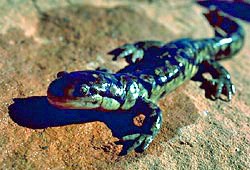|
Common Name: Tiger Salamander Scientific Name: Ambystoma tigrinum Size: 6-13 inches (15-34 cm) long Habitat: Underground burrows, meadows, forests, and shady canyons near sources of water. Diet: Earthworms, large insects, small rodents, amphibians, snails, and small crustaceans (shrimp and crayfish) Predators: Birds, snakes, ring-tailed cats, and foxes 
NPS Behavior: Tiger salamanders migrate to breeding ponds that are devoid of fish in late winter or early spring. The male and female salamander mate by circling and nudging one another. The female will eventually follow the male and pick up the spermatophore that the male deposits. The female will lay eggs that will hatch about four weeks later. Larvae will stay in the pond until they become adults in 2.5 to 5 months. After that, they will dig tunnels underground to live in during hot days and emerge at night. Conservation: Tiger Salamanders are not a threatened species, but habitat loss is the greatest threat to them. As wetlands are filled in and destroyed, tiger salamanders must search longer and farther to find good breeding ponds that are devoid of fish. Also, as the climate warms, water sources may dry up and become scarcer, eliminating this crucial environment for the Tiger Salamander. When To See: Tiger Salamanders are rare in Bryce Canyon. These reclusive creatures tend to only emerge and travel at night to avoid predators. Some have been found in Swamp Canyon and at springs within the back country trails. The best chance of seeing a Tiger Salamander is after a heavy rain, near twilight, or during the night. |
Last updated: August 26, 2024
